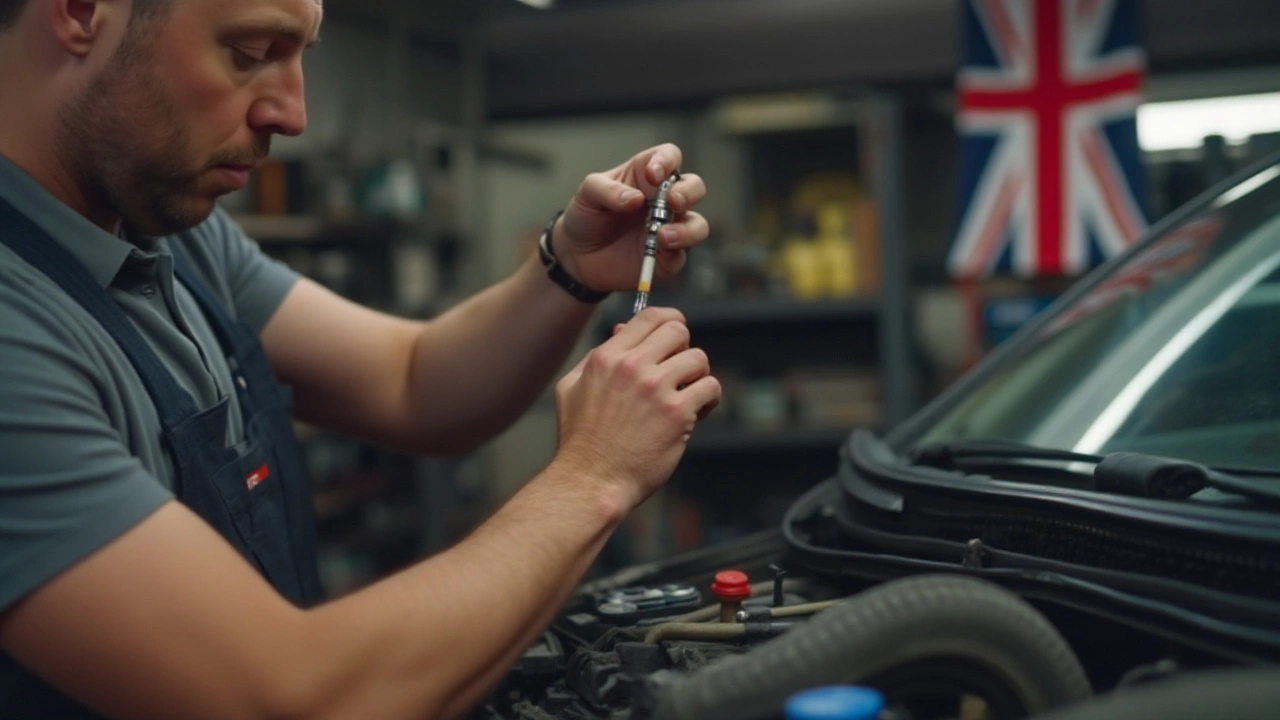Spark plugs, though small and often overlooked, are vital to the engine's performance. If these tiny powerhouses are not up to par, they can significantly impact the way your car runs. As the electrical bridge in the combustion process, spark plugs ignite the air-fuel mixture that powers your car.
Recognizing the symptoms of failing spark plugs can save you from a lot of stress and avoid costly repairs. Knowing when and how to replace them is not just the realm of expert mechanics—it's something every driver should be familiar with. Regular checks can ensure you have a smoother drive, better fuel efficiency, and a healthy engine.
In this guide, we'll explore a range of signs that could signal the need for new spark plugs and provide you with actionable advice on how to handle your car's spark plug maintenance effectively. So let's dig into the details and keep your engine firing on all cylinders!
- Understanding Spark Plugs and Their Function
- Common Signs of Worn-Out Spark Plugs
- Tips for Checking and Maintaining Spark Plugs
- When and How to Replace Spark Plugs
Understanding Spark Plugs and Their Function
In the world of car maintenance, spark plugs occupy a critical role that many drivers might not fully appreciate. These small devices could fit comfortably in the palm of your hand, yet they deliver the powerful surge of energy needed to kickstart your vehicle's engine. Each spark plug is part of a delicate dance within the internal combustion engine, working tirelessly to ignite the compressed air-fuel mixture in each cylinder. This ignition sets off a mini-explosion that generates the power necessary to propel your car forward. Without effective spark plugs, the entire performance of your engine can be compromised, making this unassuming component one of the unsung heroes of automotive engineering.
If we take a closer look at their construction, spark plugs consist of a central electrode, a ground electrode, and an insulator. The central electrode is connected to the ignition coil, which sends high-voltage electricity through it. This creates a spark that jumps across a small gap to the ground electrode, igniting the air-fuel mixture. Spark plugs need to withstand extreme temperatures and pressure inside the engine and are often made of durable materials such as iridium or platinum. These metals are capable of enduring the heat and abrasions that come with their daily duties.
The efficiency of engine performance is heavily reliant on the functioning of these high-tech plugs. A malfunction in a single plug can result in misfires, leading to jerky movements, reduced power, and increased emissions. In fact, according to data from the Car Care Council, a misfiring spark plug can reduce fuel economy by as much as 30%, not to mention the potential for serious engine damage if left unchecked for too long. This highlights the importance of regular inspections and timely replacements to ensure your vehicle runs smoothly.
A General Motors study found that changing worn spark plugs resulted in better fuel economy, showcasing the direct impact these components have on both performance and efficiency.
Interestingly, the evolution of spark plug design has mirrored advancements in automotive technology itself. While the basic operation remains unchanged, modern spark plugs are designed to be replaced less frequently, thanks to improvements in materials and manufacturing. However, despite these advancements, keeping them in optimal condition is still a key aspect of vehicle maintenance. Some spark plugs now come with pre-gapped electrodes that are specifically engineered for particular engines, helping to streamline the replacement process for car owners. Understanding the particular type needed for your vehicle is crucial, as using the wrong kind can lead to subpar performance or even cause engine damage.
For those looking to maintain their car’s engine performance, regular monitoring of spark plug health is non-negotiable. Listening to how the engine idles, checking for sluggish acceleration, or noticing any changes in fuel consumption are all ways you might indirectly check spark plug condition. When in doubt, consulting with your vehicle’s manual or a trusted mechanic can provide guidance on the recommended intervals for spark plug checks and replacements. This ensures that your vehicle not only runs efficiently but also safely.

Common Signs of Worn-Out Spark Plugs
Spark plugs are the unsung heroes of engine efficiency, working quietly behind the scenes to keep your vehicle moving. However, just like any automotive component, they don't last forever. Identifying worn-out spark plugs begins with noticing certain tell-tale symptoms that your car might exhibit. One of the first signs is poor engine performance. You might find your vehicle isn't accelerating as smoothly or as quickly as it used to. This occurs because spark plugs can't generate a sufficiently strong spark to ignite the fuel-air mixture. Consequently, the engine may run rough or stall.
An equally common indicator is decreased fuel efficiency. If you notice you're making frequent trips to the gas station, it could be due to spark plugs that are no longer operating optimally. The increased fuel consumption happens because the engine compensates for the lack of power by using more fuel to achieve the desired performance levels. As a result, you end up burning through more gas than usual, which inevitably impacts your wallet. Paying attention to your vehicle's MPG can be a good way to detect this.
Have you ever been caught off guard by an illuminated check engine light on your dashboard? It could be that it's pointing to spark plug issues. Modern cars have sophisticated diagnostics that help alert you to problems before they escalate. When spark plugs fail, they might trigger this light as they affect the engine's combustion process. While many things could cause the check engine light to come on, investigating the spark plugs is a prudent step before further damage occurs.
"A poorly maintained spark plug can cost a driver up to 30% more on gas each month," notes a leading automotive report.
Mileage is another key indicator. Most spark plugs are designed to last about 20,000 to 30,000 miles though some high-end options may stretch even further. If your car is reaching this milestone, it's a good idea to inspect or replace the spark plugs, even if no noticeable symptoms have appeared yet. Routine maintenance like this can prevent future issues. Beyond performance, listen to your engine. Misfires are a usual suspect indicative of spark plug failure. A misfire occurs when a cylinder doesn't fire correctly due to weak or no sparks. This results in a loss of power, and is often accompanied by sputtering or knocking sounds. Such noises are not just annoying—they can also signal other engine problems if left unaddressed.
Finally, engine surging is yet another symptom of worn-out spark plugs. When driving, you might feel your car unexpectedly surge forward. This can be caused by inconsistent fuel ignition from defective spark plugs. It creates moments of irregular power delivery to the engine, leading to these uncomfortable jolts or surges. Staying mindful of your car's behavior and heeding these signs can save on expensive repairs down the road. So, keep your engine's heart healthy by ensuring your spark plugs are always in prime condition.

Tips for Checking and Maintaining Spark Plugs
Checking and maintaining spark plugs is crucial for keeping your engine in prime condition. Many drivers might overlook this because it feels like such a small part of the whole vehicle, but these components are vital to ensuring your car runs safely and efficiently. Before diving into the process, ensure that your vehicle's engine is cool. A hot engine can make the process unsafe and could potentially damage new or existing plugs during adjustments. A simple rule of thumb? If it's still warm enough to touch comfortably, wait a bit longer before proceeding.
Begin by locating the spark plugs, which are generally found at the top of the engine. Cars typically have one spark plug per cylinder. So, if your vehicle has a four-cylinder engine, you'll find four spark plugs. Identifying them isn't hard; they're connected to thick wires running from the ignition coils. Carefully disconnect these wires by gripping the boot and not the wire itself to prevent any accidental breakage. Once disconnected, use a spark plug socket and wrench for removal. Remember, each spark plug will have a gap that needs to be set to the manufacturer's specification for optimal performance.
Once you've removed the plugs, inspect them closely. A healthy plug will be light brown in color, indicating proper combustion. However, if the spark plug is black and covered with oily residue, it suggests that oil is seeping into the engine combustion chamber. Alternatively, a white or blistered spark plug can signal engine overheating, a serious issue that merits further investigation. Keeping these in mind, replacing with the right type and making sure that the new ones are seated tightly but not too tight is the key—over-tightening can cause the spark plug to break or strip the engine's threads.
Regular cleaning and adjustment could extend the life of your spark plugs. To clean them, use a wire brush to remove buildup. You can also use a spray cleaner specifically designed for car engines. Gapping is another essential part of maintenance—the distance between the center and ground electrode must be correct. You can adjust these gaps using a spark plug gauge. An unequipped spark plug can cause poor engine performance, so ensuring the gap is correctly set is paramount.
While some might argue that advanced technologies have made this task less necessary, traditional spark plugs still bear a bit of manual upkeep.
"A well-maintained vehicle is like a faithful friend—it will always take care of you when you need it the most," said John Maxwell, a noted automotive specialist. As cars become more advanced, understanding these basics helps drivers remain hands-on and aware of their vehicle's needs. Even if you're not replacing the spark plugs yourself, understanding the process makes discussions with your mechanic much more insightful.Lastly, if you want to keep your car's engine in top shape, it's recommended to check the spark plugs at least once every 30,000 miles. Some high-performance variations can last longer, but it's best to reference your vehicle's manual for specific recommendations. Keeping a keen eye on your spark plugs not only maintains engine efficiency but also keeps you alert to potential underlying issues before they become severe. Also, remember, just like that first sip of coffee in the morning, a well-functioning spark plug ensures a strong start to your engine every time.

When and How to Replace Spark Plugs
Knowing the right time to replace your spark plugs is part art and part science. While most manufacturers suggest changing them every 20,000 to 40,000 miles, this number isn't set in stone. Driving habits, car model, and engine type can all affect the lifespan of your spark plugs. Let’s consider a practical approach: if you've noticed symptoms like engine misfires, rough idling, or a sudden drop in fuel efficiency, those are clear signs you're due for a new set. Modern cars often come with platinum or iridium plugs designed to last longer, sometimes up to 100,000 miles, but treating this as a guided suggestion rather than a hard rule is advisable.
Replacing spark plugs is relatively straightforward, and even if you're new to car maintenance, with a little patience and diligence, you can manage it. Start by ensuring you have the right type of spark plugs, as each car model may require a specific kind. Gather your tools: a ratchet, a spark plug socket, and a gap gauge are essentials. Before you begin, make sure the engine is cool to avoid burns. Open the hood and locate the spark plug wires or ignition coils on top of the engine. With most four-cylinder engines, the plugs line up on one side, whereas with V6 or V8 engines, you'll find them along both sides of the engine.
Gently remove the plug wire or coil from the engine block to access the plug. Use the ratchet and socket to carefully unscrew each plug, taking caution not to damage the threads within the engine. Examine the condition of the old plugs for any unusual wear that might indicate other underlying engine problems. It’s a good practice to compare the new plugs’ gaps with those specified in your vehicle’s manual, adjusting them using the gap gauge if necessary to ensure optimal engine performance. Afterward, hand-screw each new plug into its hole and tighten them with the ratchet. Be mindful of over-tightening, which could strip the threads or break the plug.
"Regularly checking your spark plugs can prevent engine issues before they happen," says Mike Allen, a former senior editor at Popular Mechanics and auto repair expert. "The key is consistency. Pay attention to changes in your car’s behavior."Once everything is set, reattach the spark plug wires or ignition coils and fire up the engine to verify everything is in working order. If your car starts smoothly, congratulations—you’ve successfully replaced your spark plugs! Much like how a fresh set of glasses can clarify your vision, new spark plugs can rejuvenate your car’s performance. Lastly, keep a log of your spark plug replacement dates and mileage to help plan for future maintenance. This routine check ensures that your engine operates efficiently and can drastically improve your car's overall longevity.






